 Database
Database
 Mysql Tutorial
Mysql Tutorial
 Summarize and sort out the pitfalls of mysql left join query that is slow and takes a long time
Summarize and sort out the pitfalls of mysql left join query that is slow and takes a long time
Summarize and sort out the pitfalls of mysql left join query that is slow and takes a long time
This article brings you relevant knowledge about mysql, which mainly introduces the summary of the pitfalls of slow left join query and long time, including the EXPLAIN command to analyze the SELECT statement, as follows Let's take a look, I hope it will be helpful to everyone.

Recommended learning: mysql video tutorial
Problem background
Two tables and one is user table a (The primary key is int type), one is user specific information table b (the user table id field is varchar type).
Because we want to display users and user information, we need to query relatedly. However, we found that the query after left join is slow and takes too long. The user table data is about 20,000.
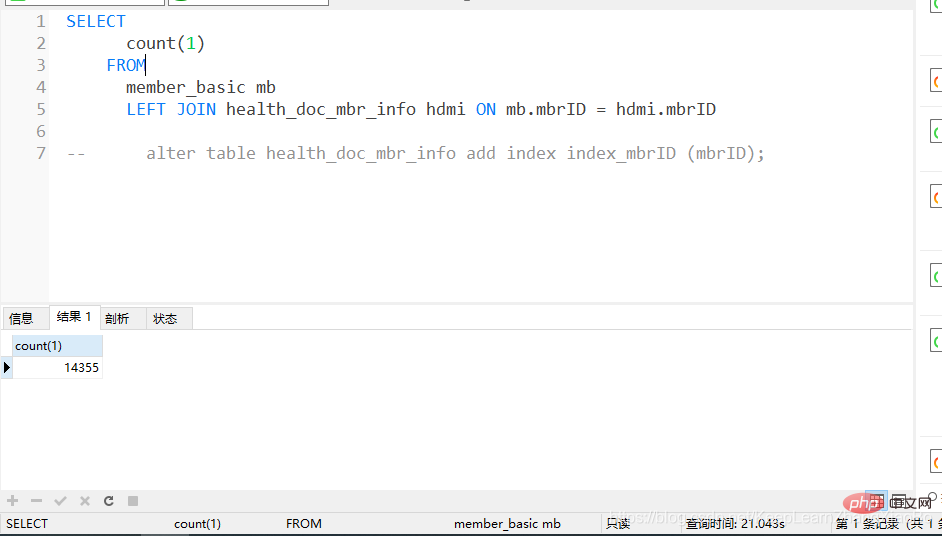
Problem analysis and processing
1. Use the EXPLAIN command to analyze the SELECT statement
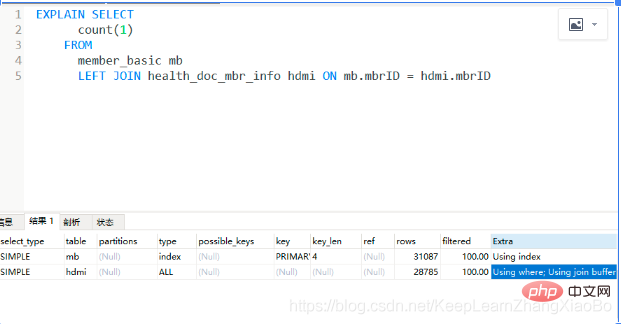
type The field provides an important basis for judging whether the query is efficient. Through the type field, we judge whether the query is a full table scan or an index scan.
ALL: Indicates a full table scan. This type of query has the highest performance. One of the worst queries.
Generally speaking, our queries should not have ALL type queries, because such queries will have a huge disaster on the performance of the database when the amount of data is large. For example, a The query is an ALL type query, so generally speaking, you can add an index to the corresponding field to avoid this.
2. New index
Because it is found that the index of field b in table has not been created before.
alter table a add index idx_mbrID (mbrID);
Explain the analysis again
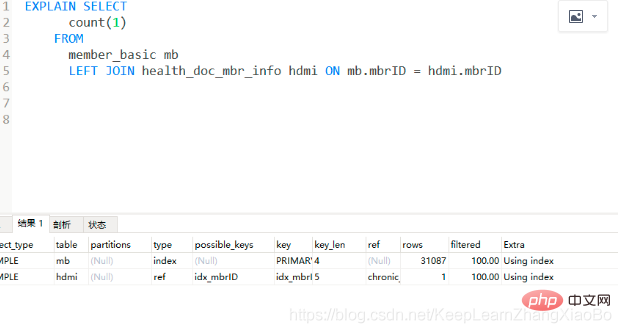
It is found that the type has changed to ref. After comparing the performance relationship of different types (
ALL < index < range ~ index_merge < ref < eq_ref < const < system
) It felt like it was OK, so I executed the query.
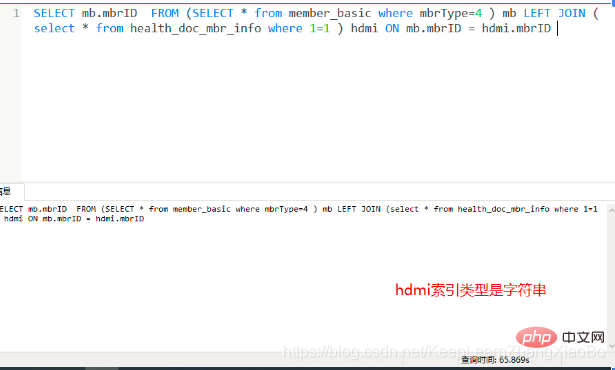
3. Modify the index field type to be consistent
After executing the query, I found that the execution speed was not optimized. I carefully looked at the table designed by my previous colleague and found that the index type field It was inconsistent, so I changed it from varchar to int and then queried again and found that the query speed was significantly improved.
Even if the string written in the java code before was changed to int in the database, the current test can be used normally
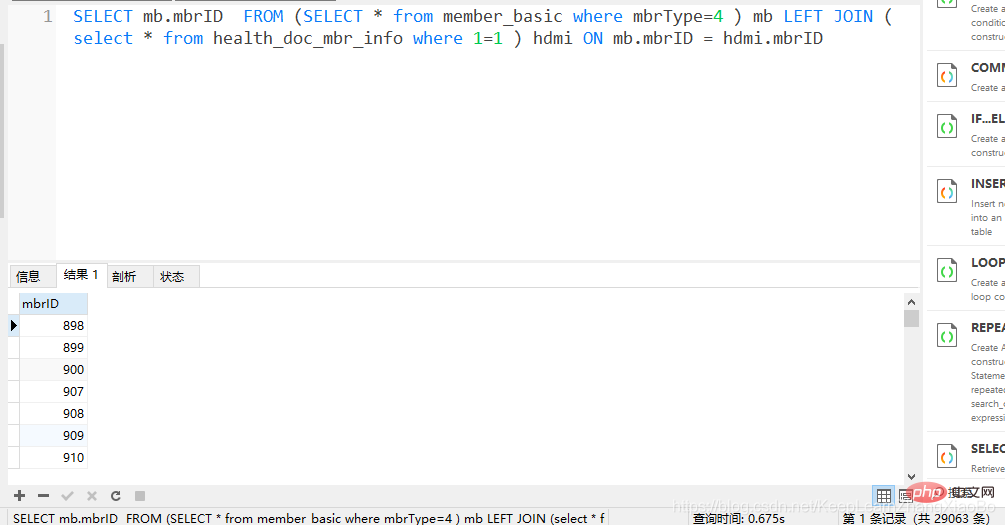
Summary
After solving the problem I flipped through the development manual and found that the index specification clearly mandates that the data types must be consistent during joins, and the related fields must have indexes! ! !

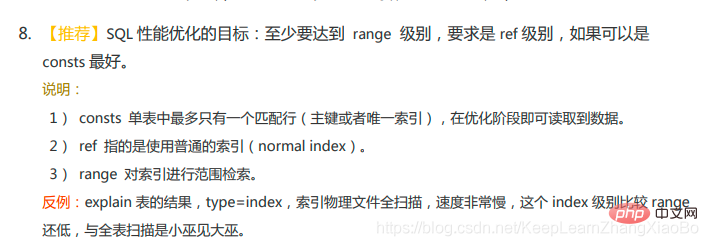
Recommended learning: mysql video tutorial
The above is the detailed content of Summarize and sort out the pitfalls of mysql left join query that is slow and takes a long time. For more information, please follow other related articles on the PHP Chinese website!

Hot AI Tools

Undresser.AI Undress
AI-powered app for creating realistic nude photos

AI Clothes Remover
Online AI tool for removing clothes from photos.

Undress AI Tool
Undress images for free

Clothoff.io
AI clothes remover

Video Face Swap
Swap faces in any video effortlessly with our completely free AI face swap tool!

Hot Article

Hot Tools

Notepad++7.3.1
Easy-to-use and free code editor

SublimeText3 Chinese version
Chinese version, very easy to use

Zend Studio 13.0.1
Powerful PHP integrated development environment

Dreamweaver CS6
Visual web development tools

SublimeText3 Mac version
God-level code editing software (SublimeText3)

Hot Topics
 1677
1677
 14
14
 1431
1431
 52
52
 1334
1334
 25
25
 1279
1279
 29
29
 1257
1257
 24
24
 Laravel Introduction Example
Apr 18, 2025 pm 12:45 PM
Laravel Introduction Example
Apr 18, 2025 pm 12:45 PM
Laravel is a PHP framework for easy building of web applications. It provides a range of powerful features including: Installation: Install the Laravel CLI globally with Composer and create applications in the project directory. Routing: Define the relationship between the URL and the handler in routes/web.php. View: Create a view in resources/views to render the application's interface. Database Integration: Provides out-of-the-box integration with databases such as MySQL and uses migration to create and modify tables. Model and Controller: The model represents the database entity and the controller processes HTTP requests.
 MySQL and phpMyAdmin: Core Features and Functions
Apr 22, 2025 am 12:12 AM
MySQL and phpMyAdmin: Core Features and Functions
Apr 22, 2025 am 12:12 AM
MySQL and phpMyAdmin are powerful database management tools. 1) MySQL is used to create databases and tables, and to execute DML and SQL queries. 2) phpMyAdmin provides an intuitive interface for database management, table structure management, data operations and user permission management.
 MySQL vs. Other Programming Languages: A Comparison
Apr 19, 2025 am 12:22 AM
MySQL vs. Other Programming Languages: A Comparison
Apr 19, 2025 am 12:22 AM
Compared with other programming languages, MySQL is mainly used to store and manage data, while other languages such as Python, Java, and C are used for logical processing and application development. MySQL is known for its high performance, scalability and cross-platform support, suitable for data management needs, while other languages have advantages in their respective fields such as data analytics, enterprise applications, and system programming.
 Laravel framework installation method
Apr 18, 2025 pm 12:54 PM
Laravel framework installation method
Apr 18, 2025 pm 12:54 PM
Article summary: This article provides detailed step-by-step instructions to guide readers on how to easily install the Laravel framework. Laravel is a powerful PHP framework that speeds up the development process of web applications. This tutorial covers the installation process from system requirements to configuring databases and setting up routing. By following these steps, readers can quickly and efficiently lay a solid foundation for their Laravel project.
 Explain the purpose of foreign keys in MySQL.
Apr 25, 2025 am 12:17 AM
Explain the purpose of foreign keys in MySQL.
Apr 25, 2025 am 12:17 AM
In MySQL, the function of foreign keys is to establish the relationship between tables and ensure the consistency and integrity of the data. Foreign keys maintain the effectiveness of data through reference integrity checks and cascading operations. Pay attention to performance optimization and avoid common errors when using them.
 Compare and contrast MySQL and MariaDB.
Apr 26, 2025 am 12:08 AM
Compare and contrast MySQL and MariaDB.
Apr 26, 2025 am 12:08 AM
The main difference between MySQL and MariaDB is performance, functionality and license: 1. MySQL is developed by Oracle, and MariaDB is its fork. 2. MariaDB may perform better in high load environments. 3.MariaDB provides more storage engines and functions. 4.MySQL adopts a dual license, and MariaDB is completely open source. The existing infrastructure, performance requirements, functional requirements and license costs should be taken into account when choosing.
 SQL vs. MySQL: Clarifying the Relationship Between the Two
Apr 24, 2025 am 12:02 AM
SQL vs. MySQL: Clarifying the Relationship Between the Two
Apr 24, 2025 am 12:02 AM
SQL is a standard language for managing relational databases, while MySQL is a database management system that uses SQL. SQL defines ways to interact with a database, including CRUD operations, while MySQL implements the SQL standard and provides additional features such as stored procedures and triggers.
 MySQL: The Database, phpMyAdmin: The Management Interface
Apr 29, 2025 am 12:44 AM
MySQL: The Database, phpMyAdmin: The Management Interface
Apr 29, 2025 am 12:44 AM
MySQL and phpMyAdmin can be effectively managed through the following steps: 1. Create and delete database: Just click in phpMyAdmin to complete. 2. Manage tables: You can create tables, modify structures, and add indexes. 3. Data operation: Supports inserting, updating, deleting data and executing SQL queries. 4. Import and export data: Supports SQL, CSV, XML and other formats. 5. Optimization and monitoring: Use the OPTIMIZETABLE command to optimize tables and use query analyzers and monitoring tools to solve performance problems.



